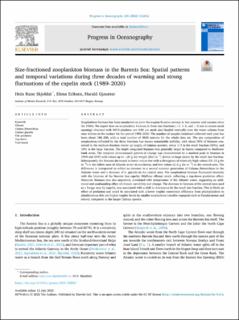| dc.contributor.author | Skjoldal, Hein Rune | |
| dc.contributor.author | Eriksen, Elena | |
| dc.contributor.author | Gjøsæter, Harald | |
| dc.date.accessioned | 2022-09-20T08:13:51Z | |
| dc.date.available | 2022-09-20T08:13:51Z | |
| dc.date.created | 2022-08-22T09:50:29Z | |
| dc.date.issued | 2022 | |
| dc.identifier.citation | Progress in Oceanography. 2022, 206 . | en_US |
| dc.identifier.issn | 0079-6611 | |
| dc.identifier.uri | https://hdl.handle.net/11250/3019039 | |
| dc.description.abstract | Zooplankton biomass has been monitored on joint Norwegian-Russian surveys in late summer and autumn since the 1980s. We report here on zooplankton biomass in three size fractions (<1, 1–2, and > 2 mm in screen mesh opening) obtained with WP-2 plankton net (180 μm mesh size) hauled vertically over the water column from near bottom to the surface for the period 1989–2020. The number of samples (stations) collected each year has been about 100–200, with a total number of 4543 stations for the whole data set. The size composition of zooplankton reflected by the three fractions has shown remarkable stability, with about 50% of biomass contained in the medium fraction (made up largely of Calanus species), about 1/3 in the small fraction (36%), and 16% in the large fraction. The depth integrated biomass was generally larger in basins compared to shallower bank areas. The temporal (interannual) pattern of change was characterized by a marked peak in biomass in 1994 and 1995 with values up to >20 g dry weight (dw) m−2, driven to large extent by the small size fraction. Subsequently the biomass decreased to lower values but with a divergence of relatively high values (10–15 g dw m−2) in the inflow area of Atlantic water in southwest, and low values (2–6 g dw m−2) in the central area. The difference is interpreted to reflect an increase in a second summer generation of Calanus finmarchicus in the Atlantic water and a decrease of C. glacialis in the central area. The zooplankton biomass fluctuated inversely with the biomass of the Barents Sea capelin (Mallotus villosus) stock, reflecting a top-down predation effect. However, biomass was also negatively correlated with temperature of the Atlantic water, suggesting an additional and confounding effect of climate variability and change. The decrease in biomass of the central area used as a forage area by capelin, was associated with a shift to dominance by the small size fraction. This is likely an effect of predation and could be associated with a lower trophic conversion efficiency from phytoplankton to planktivorous fish and higher trophic levels by smaller zooplankton (smaller copepods such as Pseudocalanus and others) compared to the larger Calanus species. | en_US |
| dc.language.iso | eng | en_US |
| dc.title | Size-fractioned zooplankton biomass in the Barents Sea: Spatial patterns and temporal variations during three decades of warming and strong fluctuations of the capelin stock (1989–2020) | en_US |
| dc.title.alternative | Size-fractioned zooplankton biomass in the Barents Sea: Spatial patterns and temporal variations during three decades of warming and strong fluctuations of the capelin stock (1989–2020) | en_US |
| dc.type | Peer reviewed | en_US |
| dc.type | Journal article | en_US |
| dc.description.version | publishedVersion | en_US |
| dc.source.pagenumber | 18 | en_US |
| dc.source.volume | 206 | en_US |
| dc.source.journal | Progress in Oceanography | en_US |
| dc.identifier.doi | 10.1016/j.pocean.2022.102852 | |
| dc.identifier.cristin | 2044815 | |
| dc.relation.project | Norges forskningsråd: 228880 | en_US |
| cristin.ispublished | true | |
| cristin.fulltext | original | |
| cristin.qualitycode | 1 | |
